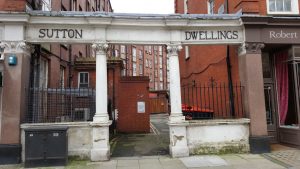
William Sutton was born on Cheapside in 1833. He ran a business delivering from shop to home – a precursor to today’s mail order! The business was successful and resulted in Sutton being worth just under £1.5 million (equivalent to £1 billion today) when he died in 1900. Sutton was one of a number of Victorian philanthropists whose donations were specifically directed towards building social housing.
Why was Sutton Dwellings needed in Chelsea? There were a number of factors that combined over a period of time to make affordable housing in the area scarce, and Sutton Dwellings partially resolved this issue.
In 1900 Chelsea was not as poor as some areas of London, but poverty in Chelsea was highlighted by the social diversity of the area. Around Sloane Street and towards Knightsbridge housing was largely for the upper middle classes. (1) In his 1889 report Booth observed that there were a few houses in the wealthy areas, such as the mews where staff or respectable shopkeepers lived. (2) As one travelled down the Kings Road the social demographics altered. ‘well to do’ could be found between Sloane Sq and Flood Street, and the areas north of Markham Street and between Sydney and Church streets were where those who were comfortably-off lived. These houses were interspersed with Artisans’ homes, which were frequently also their workshops. Between Flood and Church Streets many very poor labourers and temporary workers lived. Further down towards Worlds End and the lower part of the Kings Road small houses were occupied by wharfies and tradesmen working out of the wharfs, yards and warehouses, positioned along the Thames. (2) Overall Chelsea could not be considered as a slum when contrasted to the East End of London – but when comparison was made between the differing houses, income and communities in the area the perception that certain parts of Chelsea were impoverished would have been unavoidable.
In 1884 Chelsea was noted as having a severe sanitation problem. ”Out of 11,000-12,000 houses in Chelsea, 1,700 houses in 100 streets’‘ (2) had unacceptable sanitation in place. Concern was particularly directed towards families who lived in just one room. This was largely because houses in Chelsea that had been originally built for wealthy families when Chelsea was a small riverside resort were still standing and in use. This was due to the structure of leases and local landlords not giving permission for the houses to be redeveloped as individual apartments. (1) Therefore due to their size, these old buildings could accommodate large or even numerous families, but the buildings lacked appropriate sanitation. In other areas the houses were being replaced by modern housing and not designed for those on low incomes. They were ‘mainly for ‘rich people with artistic inclinations” (2) such as along the newly created embankment. These contemporary red brick Queen Anne mansions, still there today, were intended for the very wealthy. (2) At the end of the nineteenth century council or parish responsibilities did not really extend to providing social housing. Despite Chelsea borough council being one of the few boroughs that did start providing affordable working class homes, mostly individuals had to find private tenancies.
To help alleviate this lack of housing in the area the foundation that William Sutton had created, Sutton Estates, purchased 4.5 acres of land in Chelsea in 1908. Architect E.C.P Monson designed 674 dwellings, split between 16 blocks. By 1913 when the project was finished 2,200 people lived there. Rents were consistent with rent charged elsewhere in London, but many of the flats were designed for smaller sized families, and in particular women on low incomes, making them financially more accessible.(1)
In 1902 a quarter of Chelsea’s community officially lived in poverty, and 14% were considered to be living in overcrowded accommodation. Along with overcrowding came issues of sanitation and the potential of a health related pandemic. A programme of intervention and investigation was led by a Dr Barclay into these houses and prevented Chelsea from being affected by the epidemics that were virulent elsewhere in London. (2) Interestingly, census data today reveals that 9.2% of Chelsea and Kensington’s population lives in overcrowded circumstances. This is assessed by the ratio of number of bedrooms to residents. The Royal Borough figure is the 3rd lowest in inner London and lower than the London average of 11.6%. (3) Today there are 15 such blocks – one having been demolished in the 1970s to allow more light and access.
The Sutton trust was not the first philanthropist foundation to build social housing in Chelsea. The Peabody Trust have this honour, building houses in Lawrence Street in 1860. The Peabody building was also ground-breaking for its use of staircases as opposed to corridors – thereby reducing width and making it easier to maximise the size of the building into the available land. Other well know social housing projects were often named after their funders: Onslow Dwellings, Ocativa Hill, Chelsea Park Dwellings, and Marlborough Buildings. (2)
If you would like to read more about Sutton Dwellings George P. Landow, Professor of English and History of Art, at Brown University has written a paper that is available from the Victorian Web http://www.victorianweb.org/art/architecture/sutton/1.html See also:-
1. British History online, http://www.british-history.ac.uk/report.aspx?compid=28697&strquery=Chelsea+Census+1901 accessed 07/06/14
2. British History online, http://www.british-history.ac.uk/report.aspx?compid=28695 accessed 07/06/14
3. Royal Borough of Kensington and Chelsea, Census 2011 data, http://www.rbkc.gov.uk/pdf/Census%202011%20-%20December%20Release%20Summary.pdf accessed 07/06/15



